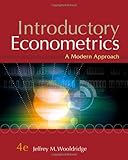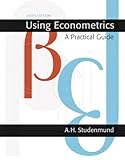|
|
Help |
| Home - Science - Econometrics (Books) | |
e99 Online Shopping Mall
|
|
Help |
| Home - Science - Econometrics (Books) | |
| 1-20 of 100 | Next 20 |
click price to see details click image to enlarge click link to go to the store
| 1. Mostly Harmless Econometrics: An Empiricist's Companion by Joshua D. Angrist, Jorn-Steffen Pischke | |
 | Paperback: 392
Pages
(2008-12-15)
list price: US$35.00 -- used & new: US$26.00 (price subject to change: see help) Asin: 0691120358 Average Customer Review: Canada | United Kingdom | Germany | France | Japan |
|
Editorial Review Product Description Customer Reviews (16)
| |
| 2. A Guide to Econometrics by Peter Kennedy | |
 | Paperback: 600
Pages
(2008-02-25)
-- used & new: US$32.38 (price subject to change: see help) Asin: 1405182571 Average Customer Review: Canada | United Kingdom | Germany | France | Japan |
|
Editorial Review Product Description Customer Reviews (40)
| |
| 3. Introductory Econometrics: A Modern Approach (with Economic Applications, Data Sets, Student Solutions Manual Printed Access Card) by Jeffrey Wooldridge | |
 | Hardcover: 888
Pages
(2008-03-27)
list price: US$193.95 -- used & new: US$120.00 (price subject to change: see help) Asin: 0324581629 Average Customer Review: Canada | United Kingdom | Germany | France | Japan |
|
Editorial Review Product Description Customer Reviews (8)
| |
| 4. Econometric Analysis by William H. Greene | |
| Hardcover: 1216
Pages
(2007-08-17)
list price: US$180.00 -- used & new: US$129.16 (price subject to change: see help) Asin: 0135132452 Average Customer Review: Canada | United Kingdom | Germany | France | Japan | |
|
Editorial Review Product Description Econometric Analysisi, 6/e serves as a bridge between an introduction to the field of econometrics and the professional literature for social scientists and other professionals in the field of social sciences, focusing on applied econometrics and theoretical background. This book provides a broad survey of the field of econometrics that allows the reader to move from here to practice in one or more specialized areas. At the same time, the reader will gain an appreciation of the common foundation of all the fields presented and use the tools they employ. This book gives space to a wide range of topics including basic econometrics, Classical, Bayesian, GMM, and Maximum likelihood, and gives special emphasis to new topics such a time series and panels. For social scientists and other professionals in the field who want a thorough introduction to applied econometrics that will prepare them for advanced study and practice in the field. Customer Reviews (61)
| |
| 5. Introductory Econometrics for Finance (Information Technology & Law S) by Chris Brooks | |
 | Paperback: 672
Pages
(2008-06-09)
list price: US$66.00 -- used & new: US$55.84 (price subject to change: see help) Asin: 052169468X Average Customer Review: Canada | United Kingdom | Germany | France | Japan |
|
Editorial Review Product Description Customer Reviews (17)
| |
| 6. Schaum's Outline of Statistics and Econometrics by Dominick Salvatore, Derrick Reagle | |
 | Paperback: 256
Pages
(2001-10-23)
list price: US$19.95 -- used & new: US$11.12 (price subject to change: see help) Asin: 0071348522 Average Customer Review: Canada | United Kingdom | Germany | France | Japan |
|
Editorial Review Product Description Customer Reviews (4)
| |
| 7. Econometric Analysis of Cross Section and Panel Data by Jeffrey M. Wooldridge | |
 | Hardcover: 776
Pages
(2001-10-01)
list price: US$82.00 -- used & new: US$65.00 (price subject to change: see help) Asin: 0262232197 Average Customer Review: Canada | United Kingdom | Germany | France | Japan |
|
Editorial Review Product Description The book focuses specifically on cross section and panel data methods. Population assumptions are stated separately from sampling assumptions, leading to simple statements as well as to important insights. The unified approach to linear and nonlinear models and to cross section and panel data enables straightforward coverage of more advanced methods. The numerous end-of-chapter problems are an important component of the book. Some problems contain important points not fully described in the text, and others cover new ideas that can be analyzed using tools presented in the current and previous chapters. Several problems require the use of the data sets included with the book. Customer Reviews (16)
| |
| 8. Econometrics by Fumio Hayashi | |
 | Hardcover: 690
Pages
(2000-12-15)
list price: US$99.50 -- used & new: US$36.68 (price subject to change: see help) Asin: 0691010188 Average Customer Review: Canada | United Kingdom | Germany | France | Japan |
|
Editorial Review Product Description Econometrics has many useful features and covers all the important topics in econometrics in a succinct manner. All the estimation techniques that could possibly be taught in a first-year graduate course, except maximum likelihood, are treated as special cases of GMM (generalized methods of moments). Maximum likelihood estimators for a variety of models (such as probit and tobit) are collected in a separate chapter. This arrangement enables students to learn various estimation techniques in an efficient manner. Eight of the ten chapters include a serious empirical application drawn from labor economics, industrial organization, domestic and international finance, and macroeconomics. These empirical exercises at the end of each chapter provide students a hands-on experience applying the techniques covered in the chapter. The exposition is rigorous yet accessible to students who have a working knowledge of very basic linear algebra and probability theory. All the results are stated as propositions, so that students can see the points of the discussion and also the conditions under which those results hold. Most propositions are proved in the text. For those who intend to write a thesis on applied topics, the empirical applications of the book are a good way to learn how to conduct empirical research. For the theoretically inclined, the no-compromise treatment of the basic techniques is a good preparation for more advanced theory courses. Customer Reviews (17)
| |
| 9. Introduction to Econometrics, 2nd Edition (Addison-Wesley Series in Economics) by James H. Stock, Mark W. Watson | |
 | Hardcover: 796
Pages
(2006-07-31)
list price: US$180.00 -- used & new: US$105.00 (price subject to change: see help) Asin: 0321278879 Average Customer Review: Canada | United Kingdom | Germany | France | Japan |
|
Editorial Review Product Description Customer Reviews (19)
| |
| 10. Basic Econometrics by Damodar N. Gujarati | |
 | Paperback: 800
Pages
(2009-01-01)
list price: US$71.05 -- used & new: US$52.46 (price subject to change: see help) Asin: 0071276254 Average Customer Review: Canada | United Kingdom | Germany | France | Japan |
|
Editorial Review Product Description Customer Reviews (30)
| |
| 11. Introductory Econometrics: A Modern Approach (with Economic Applications Online, Econometrics Data Sets with Solutions Manual Web Site Printed Access Card) by Jeffrey Wooldridge | |
 | Hardcover: 900
Pages
(2005-07-13)
list price: US$211.95 -- used & new: US$100.00 (price subject to change: see help) Asin: 0324289782 Average Customer Review: Canada | United Kingdom | Germany | France | Japan |
|
Editorial Review Product Description Customer Reviews (21)
| |
| 12. Using Econometrics: A Practical Guide (6th Edition) (Pearson Series in Economics) by A.H. Studenmund | |
 | Hardcover: 648
Pages
(2010-01-13)
list price: US$180.00 -- used & new: US$99.50 (price subject to change: see help) Asin: 0131367730 Average Customer Review: Canada | United Kingdom | Germany | France | Japan |
|
Editorial Review Product Description Customer Reviews (1)
| |
| 13. Principles of Econometrics by R. Carter Hill, William E. Griffiths, Guay C. Lim | |
 | Hardcover: 608
Pages
(2007-11-27)
-- used & new: US$45.00 (price subject to change: see help) Asin: 0471723606 Average Customer Review: Canada | United Kingdom | Germany | France | Japan |
|
Editorial Review Product Description Customer Reviews (9)
| |
| 14. Essentials of Econometrics by Damodar Gujarati, Dawn Porter | |
 | Hardcover: 576
Pages
(2009-05-12)
-- used & new: US$73.00 (price subject to change: see help) Asin: 0073375845 Average Customer Review: Canada | United Kingdom | Germany | France | Japan |
|
Editorial Review Product Description Customer Reviews (13)
| |
| 15. Applied Econometric Times Series (Wiley Series in Probability and Statistics) by Walter Enders | |
 | Hardcover: 544
Pages
(2009-11-02)
-- used & new: US$58.47 (price subject to change: see help) Asin: 0470505397 Average Customer Review: Canada | United Kingdom | Germany | France | Japan |
|
Editorial Review Product Description Customer Reviews (13)
| |
| 16. Solutions Manual and Supplementary Materials for Econometric Analysis of Cross Section and Panel Data by Jeffrey M. Wooldridge | |
 | Paperback: 250
Pages
(2003-09-14)
list price: US$28.00 -- used & new: US$27.72 (price subject to change: see help) Asin: 0262232332 Average Customer Review: Canada | United Kingdom | Germany | France | Japan |
|
Editorial Review Product Description Customer Reviews (2)
| |
| 17. A Course in Econometrics by Arthur S. Goldberger | |
 | Hardcover: 432
Pages
(1991-04-15)
list price: US$75.50 -- used & new: US$71.01 (price subject to change: see help) Asin: 0674175441 Average Customer Review: Canada | United Kingdom | Germany | France | Japan |
|
Editorial Review Product Description This text prepares first-year graduate students and advanced undergraduates for empirical research in economics, and also equips them for specialization in econometric theory, business, and sociology. A Course in Econometrics is likely to be the text most thoroughly attuned to the needs of your students. Derived from the course taught by Arthur S. Goldberger at the University of Wisconsin-Madison and at Stanford University, it is specifically designed for use over two semesters, offers students the most thorough grounding in introductory statistical inference, and offers a substantial amount of interpretive material. The text brims with insights, strikes a balance between rigor and intuition, and provokes students to form their own critical opinions. A Course in Econometrics thoroughly covers the fundamentals—classical regression and simultaneous equations—and offers clear and logical explorations of asymptotic theory and nonlinear regression. To accommodate students with various levels of preparation, the text opens with a thorough review of statistical concepts and methods, then proceeds to the regression model and its variants. Bold subheadings introduce and highlight key concepts throughout each chapter. Each chapter concludes with a set of exercises specifically designed to reinforce and extend the material covered. Many of the exercises include real micro-data analyses, and all are ideally suited to use as homework and test questions. Customer Reviews (10)
| |
| 18. Using Econometrics: A Practical Guide (5th Edition) by A.H. Studenmund | |
 | Hardcover: 656
Pages
(2005-06-11)
list price: US$180.00 -- used & new: US$19.93 (price subject to change: see help) Asin: 0321316495 Average Customer Review: Canada | United Kingdom | Germany | France | Japan |
|
Editorial Review Product Description Customer Reviews (5)
| |
| 19. Introductory Econometrics with Applications (Dryden Press Series in Marketing) by Ramu Ramanathan | |
 | Hardcover: 688
Pages
(2002-01)
list price: US$65.25 -- used & new: US$147.91 (price subject to change: see help) Asin: 0030341868 Average Customer Review: Canada | United Kingdom | Germany | France | Japan |
|
Editorial Review Product Description Customer Reviews (13)
| |
| 20. A Guide to Modern Econometrics by Marno Verbeek | |
 | Paperback: 488
Pages
(2008-05-27)
-- used & new: US$52.24 (price subject to change: see help) Asin: 0470517697 Average Customer Review: Canada | United Kingdom | Germany | France | Japan |
|
Editorial Review Product Description Customer Reviews (7)
| |
| 1-20 of 100 | Next 20 |